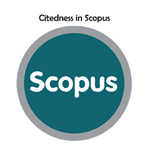Hubungan Jumlah Peresepan Obat Terhadap Potensially Inapropriate Medications Berdasarkan Beers Criteria 2019 Pasien Diabetes Mellitus
Abstract
Keywords
Full Text:
PDFReferences
B. P. Statistik, "Profil Perempuan Indonesia 2019" Kementeri. Pemberdaya. Peremp. dan Perlindungan Anak, 2019.
Kemenkes RI, "Hasil Riset Kesehatan Dasar Tahun 2018" Kementrian Kesehat. RI, vol. 53, no. 9, pp. 1689-1699, 2018.
N. S. A. Gumilas, "Karakteristik penderita diabetes melitus (DM) tipe 2 di Purwokerto" in Prosiding Seminar Nasional LPPM Unsoed, 2019, vol. 8, no. 1.
M. J. Samuel, "American Geriatrics Society 2015 updated beers criteria for potentially inappropriate medication use in older adults" J. Am. Geriatr. Soc., vol. 63, no. 11, pp. 2227-2246, 2015, doi: 10.1111/jgs.13702.
E. A. Widyaningrum, K. S. PDW, L. W. Astuti, S. Suhartatik, R. Rimawati, and E. K. Sari, "Correlation Between the Number of Drugs Prescribed and Potentially Inappropriate Medication (PIMS) Based on Beers Criteria in Geriatric Hypertension Outpatients at Dr. Soedomo Hospital in Trenggalek" J. Farm. Galen. (Galenika J. Pharmacy)(e-Journal), vol. 7, no. 3, pp. 238-250, 2021.
M. Sugiyono, "Kualitataif dan r&d, Bandung: Alfabeta, 2010" Sugiyono, Metod. Penelit. Kuantitatif Kualitatif Dan R&D Bandung Alf., 2007.
D. Irawan, "Prevalensi dan faktor risiko kejadian diabetes melitus tipe 2 di Daerah Urban Indonesia (Analisa Data Sekunder Riskesdas 2007)." Thesis Universitas Indonesia, 2010.
N. Isnaini and R. Ratnasari, "Faktor risiko mempengaruhi kejadian Diabetes mellitus tipe dua" J. Kebidanan Dan Keperawatan Aisyiyah, vol. 14, no. 1, pp. 59-68, 2018.
A. Zulkarnaini and R. D. Martini, "Gambaran Polifarmasi Pasien Geriatri Dibeberapa Poliklinik RSUP Dr. M. Djamil Padang" J. Kesehat. Andalas, vol. 8, no. 1S, pp. 1-6, 2019.
W. H. Organization, Global diffusion of eHealth: making universal health coverage achievable: report of the third global survey on eHealth. World Health Organization, 2017.
K. Asplund et al., "Geriatric"based versus general wards for older acute medical patients: a randomized comparison of outcomes and use of resources" J. Am. Geriatr. Soc., vol. 48, no. 11, pp. 1381-1388, 2000.
D. C. Guimarães e Silva, M. L. Pereira, D. B. Soares, A. I. Loyola-Filho, and M. M. G. Nascimento, "Potentially Inappropriate Medication Use Among Older Hospitalized Patients in a Brazilian General Hospital" Infarma - Ciências Farm., vol. 28, no. 1, pp. 27-32, 2016, doi: 10.14450/2318-9312.v28.e1.a2016.pp27-32.
2019 American Geriatrics Society Beers Criteria® Update Expert Panel et al., "American Geriatrics Society 2019 updated AGS Beers Criteria® for potentially inappropriate medication use in older adults" J. Am. Geriatr. Soc., vol. 67, no. 4, pp. 674-694, 2019.
R. Charfi, M. Ben Sassi, E. Gaies, N. Jebabli, R. Daghfous, and S. Trabelsi, "Digoxin therapeutic drug monitoring: age influence and adverse events Suivi thérapeutique pharmacologique de la digoxine: influence de l'âge et effets indésirables" Tunis. Med., vol. 98, no. 01, 2020.
F. M. Amrulloh and N. Utami, "Hubungan Konsumsi OAINS terhadap Gastritis The Relation of NSAID Consumption to Gastritis" Majority, vol. 5, pp. 18-21, 2016.
DOI: https://doi.org/10.37311/ijpe.v3i2.19752
Refbacks
- There are currently no refbacks.
Copyright (c) 2023 Kumala Sari Poespita Dewi Wahyuni, Esti Ambar Widyaningrum, Erni Anika Sari, Dwitania Noerhalizah

Indonesian Journal of Pharmaceutical Education is licensed under a Creative Commons Attribution-NonCommercial-ShareAlike 4.0 International License.



